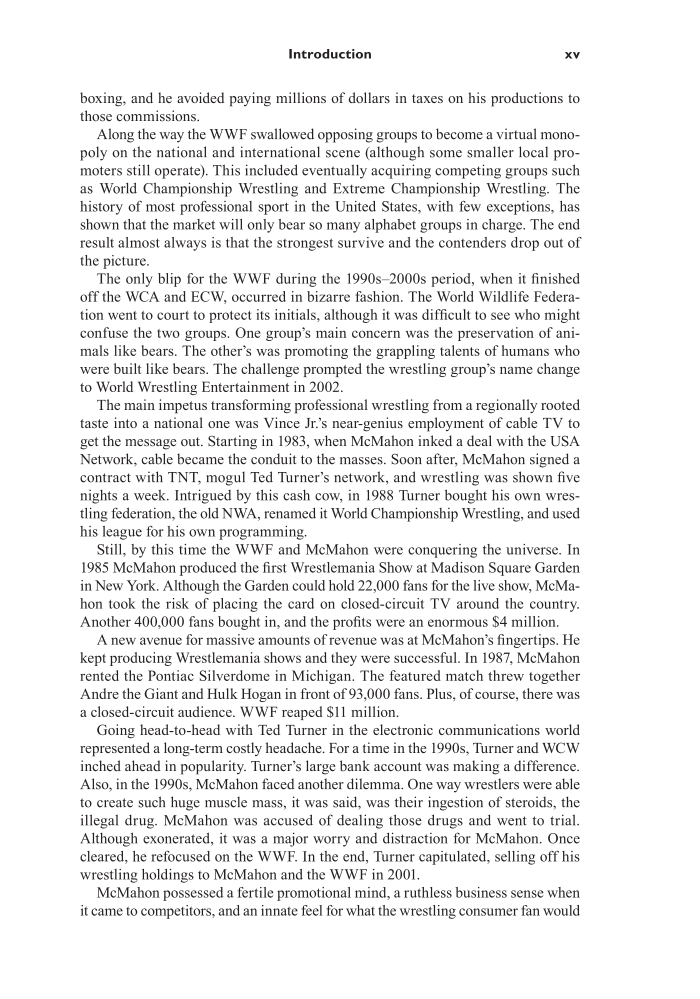Introduction xv boxing, and he avoided paying millions of dollars in taxes on his productions to those commissions. Along the way the WWF swallowed opposing groups to become a virtual mono poly on the national and international scene (although some smaller local pro- moters still operate). This included eventually acquiring competing groups such as World Championship Wrestling and Extreme Championship Wrestling. The history of most professional sport in the United States, with few exceptions, has shown that the market will only bear so many alphabet groups in charge. The end result almost always is that the strongest survive and the contenders drop out of the picture. The only blip for the WWF during the 1990s–2000s period, when it finished off the WCA and ECW, occurred in bizarre fashion. The World Wildlife Federa- tion went to court to protect its initials, although it was difficult to see who might confuse the two groups. One group’s main concern was the preservation of ani- mals like bears. The other’s was promoting the grappling talents of humans who were built like bears. The challenge prompted the wrestling group’s name change to World Wrestling Entertainment in 2002. The main impetus transforming professional wrestling from a regionally rooted taste into a national one was Vince Jr.’s near- genius employment of cable TV to get the message out. Starting in 1983, when McMahon inked a deal with the USA Network, cable became the conduit to the masses. Soon after, McMahon signed a contract with TNT, mogul Ted Turner’s network, and wrestling was shown five nights a week. Intrigued by this cash cow, in 1988 Turner bought his own wres- tling federation, the old NWA, renamed it World Championship Wrestling, and used his league for his own programming. Still, by this time the WWF and McMahon were conquering the universe. In 1985 McMahon produced the first Wrestlemania Show at Madison Square Garden in New York. Although the Garden could hold 22,000 fans for the live show, McMa- hon took the risk of placing the card on closed- circuit TV around the country. Another 400,000 fans bought in, and the profits were an enormous $4 million. A new ave nue for massive amounts of revenue was at McMahon’s fingertips. He kept producing Wrestlemania shows and they were successful. In 1987, McMahon rented the Pontiac Silverdome in Michigan. The featured match threw together Andre the Giant and Hulk Hogan in front of 93,000 fans. Plus, of course, there was a closed- circuit audience. WWF reaped $11 million. Going head-to-head with Ted Turner in the electronic communications world represented a long-term costly headache. For a time in the 1990s, Turner and WCW inched ahead in popularity. Turner’s large bank account was making a difference. Also, in the 1990s, McMahon faced another dilemma. One way wrestlers were able to create such huge muscle mass, it was said, was their ingestion of steroids, the illegal drug. McMahon was accused of dealing those drugs and went to trial. Although exonerated, it was a major worry and distraction for McMahon. Once cleared, he refocused on the WWF. In the end, Turner capitulated, selling off his wrestling holdings to McMahon and the WWF in 2001. McMahon possessed a fertile promotional mind, a ruthless business sense when it came to competitors, and an innate feel for what the wrestling consumer fan would
Document Details My Account Print multiple pages
Print
You have printed 0 times in the last 24 hours.
Your print count will reset on at .
You may print 0 more time(s) before then.
You may print a maximum of 0 pages at a time.









































































































































































































































































































































